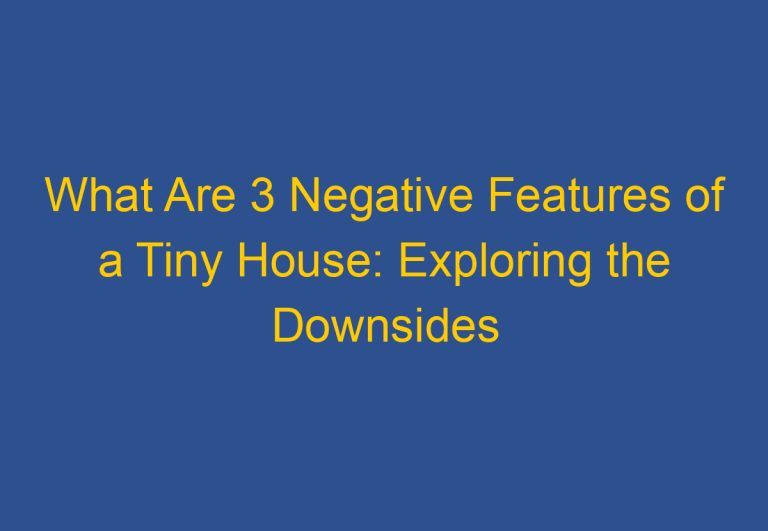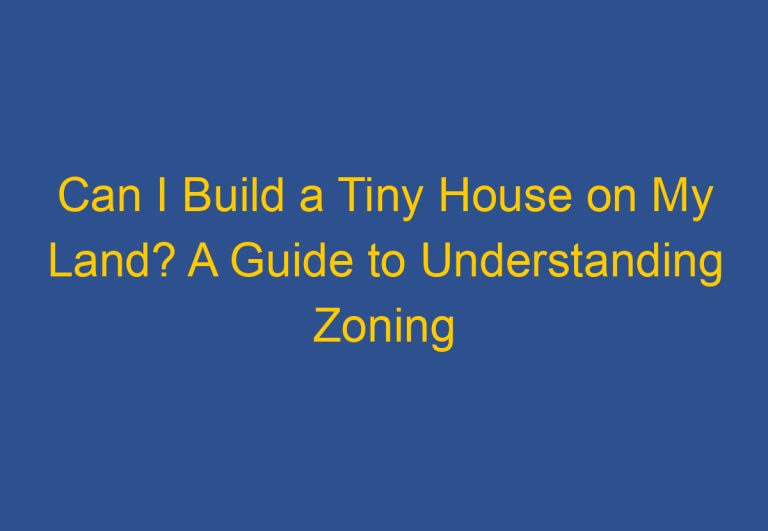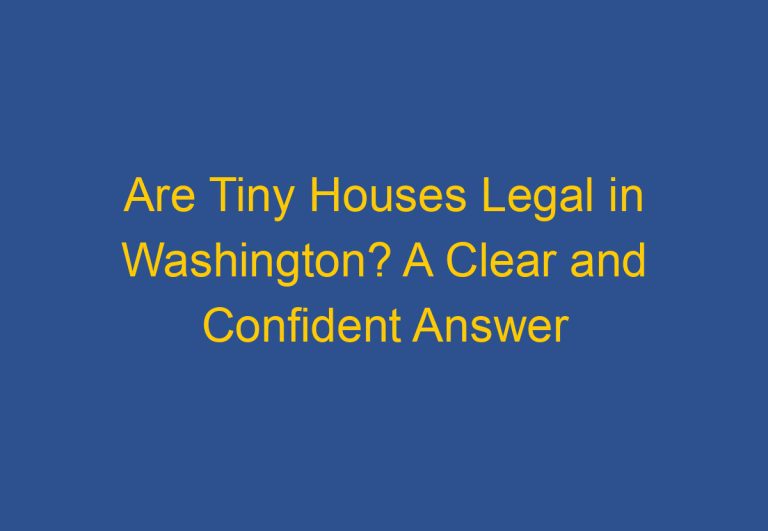Are Tiny Houses Legal? A Comprehensive Guide to Tiny House Regulations in the US
Tiny houses have become a popular trend in recent years, offering an affordable and minimalist lifestyle for those looking to downsize. However, many people wonder if these tiny homes are even legal. The answer is not a simple yes or no, as the legality of tiny houses varies depending on a variety of factors, including location, size, and building codes.
In general, tiny houses are legal as long as they meet certain requirements. For example, some states have specific laws for tiny houses, while others treat them the same as any other type of dwelling. Additionally, tiny homes built on foundations are typically easier to make legal than those built on wheels, which are often classified as RVs and subject to different regulations. It’s important to research the laws in your area before building or purchasing a tiny house to ensure that you are in compliance with all applicable regulations.
Overall, while the legality of tiny houses can be complex, it is possible to live in one legally with the right planning and research. By understanding the regulations in your area and ensuring that your tiny home meets all necessary requirements, you can enjoy the benefits of a minimalist lifestyle without running afoul of the law.
Legality and Zoning Regulations
When it comes to tiny houses, one of the biggest concerns is their legality. Understanding zoning laws, state and city-specific regulations, building codes, and safety standards is crucial for anyone considering living in a tiny home.
Understanding Zoning Laws
Zoning laws dictate where and how tiny houses can be located within a particular jurisdiction. These laws vary widely by state, city, and even county. Some areas have embraced the tiny house movement and have passed legislation allowing for the legal construction and residence of tiny homes. For example, Pima County in Arizona has specific zoning regulations for tiny homes, and Spur and Austin in Texas have created tiny home communities.
However, in many areas, tiny homes are considered illegal and can’t be parked in most places due to local zoning regulations. It’s essential to research the zoning laws in your area before deciding to build or move into a tiny home.
State and City Specific Regulations
In the United States, some states have outlined specific laws for tiny houses. For instance, Oregon was the first state to adopt tiny house building codes and zoning regulations. California, Florida, New York, North Dakota, Texas, Washington, and West Virginia have also passed laws related to tiny homes.
However, even within these states, regulations can vary by city or county. For example, in Fresno, California, tiny houses are allowed in the backyards of existing homes, while in Virginia, tiny homes must be on a foundation and meet the International Residential Code (IRC).
Building Codes and Safety Standards
Regardless of where you live, proper building permits must be acquired in all states, and builders must follow all zoning regulations, building codes, and safety standards. It’s essential to ensure that your tiny home meets all the necessary requirements to avoid any legal issues.
In summary, while tiny houses offer an alternative to traditional larger homes, their legality and zoning regulations are crucial considerations. Understanding the zoning laws, state and city-specific regulations, building codes, and safety standards is essential for anyone considering living in a tiny home.
Living in a Tiny House
Living in a tiny house is a lifestyle choice that has gained popularity in recent years. Tiny houses are typically defined as residential structures that are 400 square feet or less, and they can come in many different forms, including tiny homes on wheels, park model RVs, and accessory dwelling units.
Types of Tiny Houses
There are several different types of tiny houses, each with their own unique features and benefits. Tiny homes on wheels are popular because they are mobile and can be moved from one location to another. Park model RVs are designed to be stationary and are often used as guest houses or vacation homes. Accessory dwelling units, or ADUs, are tiny houses that are built in a backyard or on a piece of property and are used as a secondary residence.
Challenges and Considerations
Living in a tiny house comes with its own set of challenges and considerations. One of the biggest challenges is finding a place to park the tiny house. Many cities and towns have local ordinances that restrict the placement of tiny houses, and it can be difficult to find a location that is legal and safe. Additionally, facilities such as plumbing and electricity can be more difficult to install and maintain in a tiny house due to limited space.
Another consideration when living in a tiny house is the ceiling height and stairs. Many tiny houses have lofts that require climbing a ladder or steep stairs, which can be difficult for some people. Additionally, the limited square footage can make it difficult to store belongings and maintain a clutter-free living space.
Community and Lifestyle
Despite the challenges, many people choose to live in a tiny house because of the sense of community and lifestyle it provides. Tiny house communities are popping up all over the country, offering a sense of belonging and shared values. The tiny house movement is also focused on sustainability and minimalism, which can be appealing to those who want to live a more eco-friendly and intentional lifestyle.
In terms of legal considerations, it’s important to note that tiny house laws vary by location. Some states and cities have more lenient regulations for tiny houses, while others consider them illegal. It’s important to research local ordinances and DMV regulations before purchasing or building a tiny house to ensure that it is legal and safe.
Frequently Asked Questions
Do zoning laws affect tiny house legality in various states?
Yes, zoning laws can affect the legality of tiny houses in various states. Zoning laws can impose minimum size and design requirements, such as minimum square footage, height restrictions, and setbacks from property lines. These regulations can impact the design and layout of tiny homes. It is essential to research the zoning laws in the state where you plan to build your tiny house to ensure that you comply with the regulations.
What are the building code requirements for tiny houses?
Traditional tiny houses on a foundation must adhere to international building codes to be considered permanent residences. The building code requirements for tiny houses vary depending on the state and locality. In some states, tiny houses must comply with the same building codes as traditional homes, while in others, they may have different requirements. It is crucial to research the building code requirements in your state and locality to ensure that you comply with the regulations.
Are there specific states where tiny houses are more accepted?
Yes, some states are more accepting of tiny houses than others. Some states have passed laws specifically addressing tiny houses, while others have not. States such as Colorado, California, Oregon, and Texas have more relaxed regulations on tiny houses. However, it is essential to research the regulations in the state where you plan to build your tiny house to ensure that you comply with the regulations.
How do local ordinances impact tiny house living?
Local ordinances can impact tiny house living. Local governments can impose regulations on the use of land, including the use of tiny houses. It is essential to research the local ordinances in the area where you plan to live in your tiny house to ensure that you comply with the regulations.
What is the minimum square footage for a legal dwelling?
The minimum square footage for a legal dwelling varies depending on the state and locality. In some states, such as Illinois, the square footage for a tiny house to be considered a legal dwelling is 150 square feet. The total square footage of a tiny house cannot exceed 400 square feet. However, this code only applies to permanent dwellings. It is crucial to research the minimum square footage requirements in your state and locality to ensure that you comply with the regulations.
Can you legally live in a tiny house on your own land?
Yes, you can legally live in a tiny house on your land, provided that you comply with the local zoning and building codes. It is essential to research the regulations in your state and locality to ensure that you comply with the regulations.










